|
|
|||
|
(Back to Preceding Week; on to Next Week) |
|
Week One is full and Week Three has only one slot remaining for our annual |
|
GOLDFINCH MYSTERY When summer wanes and leaves begin to fall at Hilton Pond Center the oranges and reds of autumn foliage are always highlighted by yellow plumage of a few American Goldfinches raiding our feeders. The goldfinch flock grows almost exponentially as cold weather approaches, and most winters our "wild canaries" are joined by equal or greater numbers of Purple Finches and House Finches.
All text, maps, charts & photos © Hilton Pond Center According to results compiled by observers for the U.S. Geological Survey's Breeding Bird Survey (BBS), during the past 50 years American Goldfinches (AMGO) have been detected during breeding seasons within in the broad area shown on the map above. Their densest numbers appear to be in New England, the Upper Midwest, and Great Lakes States, with dense pockets in north central North Carolina and elsewhere. All text, maps, charts & photos © Hilton Pond Center Click on map above to open a larger version in a new browser window The breeding population in South Carolina is apparently much smaller, with relatively few nests or singing males detected as part of the state's Breeding Bird Atlas (1988-1995). In the Palmetto State (above), nearly all AMGO breeding records are from the Piedmont or Mountain Provinces, with one confirmed nest in the Sandhills (Florence County). Both the U.S.-Canadian Breeding Bird Survey and the South Carolina Breeding Bird Atlas are snapshots bound to miss many nesting records--notice there is even a slight discrepancy for South Carolina between the two maps--but these inventories stand as the most definitive descriptions we have for general breeding ranges of various bird species--including American Goldfinches.
All text, maps, charts & photos © Hilton Pond Center Last winter we were entertained by the antics of a record-breaking number of American Goldfinches, Carduelis tristis, including the female above. Her non-breeding plumage includes olive body and head feathers, brownish-black wings, and a pair of distinctly white wing bars. The bill is dark except for a bone-colored area at the base of the lower mandible.
All text, maps, charts & photos © Hilton Pond Center As winter turned to spring, our drab AMGO males went calico (above), replacing olive body plumage with yellow and bringing in their black foreheads. Their jet-black wings were marked--as in the female--with pristine white wing bars, i.e., the tips of the lesser and greater primary coverts.
All text, maps, charts & photos © Hilton Pond Center As spring progressed and both sexes got brighter yellow (male above, female below), their dark bills turned bright orange when melanin was replaced by carotenoid pigments in the bill's sheath.
All text, maps, charts & photos © Hilton Pond Center We've always found it peculiar male and female American Goldfinches go through their spring molt at the same time as other local breeding birds; it's odd because those other species start nesting in April and May while goldfinches are among the last of our Carolina songbirds to lay eggs and raise young. By the time they acquire breeding attire, most of Hilton Pond's wintering goldfinches have already migrated or are about to, while the few that remain continue to frequent sunflower and thistle seeds we offer year-round. Historically, goldfinches in most of their breeding range do wait until August to begin nesting--well after the time when most other songbird species are already finished for the year. Conventional wisdom says goldfinches require native thistle seeds (as depicted by John James Audubon, above left) to nurture their chicks, and many native thistles don't ripen until late summer. (Note that Niger seeds we offer in feeders are typically imported as modern-day substitutes for native thistle seeds.) Goldfinches make good use of native thistle; in addition to feeding its tiny fruits to their young, goldfinches also break feathery "wings" from the seeds and line their nests with the soft, downy material. As noted, most years at Hilton Pond Center our big winter flocks of American Goldfinches essentially disappear by mid-summer, with only a few birds hanging around through July, August, and September. In 2008, however, we had a noticeably larger population, as indicated by the table below.
All text, maps, charts & photos © Hilton Pond Center The table above shows year-by-year totals for American Goldfinches banded at Hilton Pond Center during "summer" months of July, August, and September. (We also list birds banded in June but do not include them in our analysis because some could have been late migrants.) When we add all the summer goldfinches from the three months for a given year, we see that in 2008 we banded 41 individuals--more than twice as many as we've ever banded in that time period. Our previous best total was last year, when we caught 16. At first we thought these relatively big summer totals for 2007 and 2008 could have occurred simply because we simply banded a lot of American Goldfinches during those two calendar years, so we compared the number of summer bandings to the number of captures for the whole calendar year. This revealed we not only banded many more AMGO than usual this summer, but that these summer birds made up a significantly higher percentage (8%) than any previous year except 1984 and 2001. This suggests the high number of summer birds this year was not just a reflection of high winter populations. (Caveat: We'll likely catch many more AMGO between now and 31 December, increasing the 2008 total and bringing down the percentage of "summer" birds. Even so, we'd have to band a whopping 300 additional AMGO just to lower our 2008 percentage to the 26-year summer bird average of 3%.)
All text, maps, charts & photos © Hilton Pond Center Analyzing our 26-year results led us to look even more closely at our 2008 banding info. This showed us not only that we had a bigger breeding population but that our summering American Goldfinches were successful at producing offspring. We had already suspected this because during August and September we continued to capture and band young goldfinches that had fledged recently--as shown by their black bills, drab plumage, and buffy (not white) wing bars (above and below).
All text, maps, charts & photos © Hilton Pond Center Of the 41 AMGO banded in July 2008, one was an adult female and two were adult males. In August, we banded one adult female, three adult males, and seven juveniles (three males, three females, one unknown sex). In September, we caught a whopping total of 24 juveniles (13 males, 11 females) and three new adults (one male, two females). In all, three-quarters (31 of 41) AMGO banded July through September were recent fledglings. Most years we're lucky to see even one in that span.
All text, maps, charts & photos © Hilton Pond Center We should mention that ALL adult female AMGO we captured in August and September 2008 had lost their belly feathers and bore well-developed, edematous, highly vascularized "incubation patches" that are very strong evidence for local breeding. And, since the young goldfinches we caught were obvious recent fledglings (above), they couldn't have flown very far. We haven't yet found a goldfinch nest at Hilton Pond Center, but if the species is not breeding right on the property their nests almost certainly are on adjoining farmland. In any case, we're not sure what might have changed in 2008 to bring such a big increase in local breeding, but we'd be interested in hearing what other observers in the Southeast and elsewhere have to report as we try to solve this new "Goldfinch Mystery."
All text, maps, charts & photos © Hilton Pond Center Comments or questions about this week's installment?
Thanks to the following fine folks for recent gifts in support of Hilton Pond Center for Piedmont Natural History and/or Operation RubyThroat: The Hummingbird Project. Your tax-deductible contributions allow us to continue writing, photographing, and sharing "This Week at Hilton Pond." (Please see Support if you'd like to make a gift of your own.)
"This Week at Hilton Pond" is written & photographed You may wish to consult our Index of all nature topics covered since February 2000. You can also use our on-line Hilton Pond Search Engine at the bottom of this page. For a free, non-fattening, on-line subscription to |
||||||||||||||||||||||||||||||||||||||||||||||||||||||||||||||||||||||||||||||||||||||||||||||||||||||||||||||||||||||||||||||||||||||||||||||||||||||||||||||||||||||||||||||||||||||||||||||||||||||||||||||||||||||||||||||||||||||||||||||||
|
Make direct donations on-line via
Network for Good: |
|
|
Use your PayPal account
to make direct donations: |
|
|
If you like to shop on-line, you please become a member of iGive, through which more than 700 on-line stores from Barnes & Noble to Lands' End will donate a percentage of your purchase price in support of Hilton Pond Center and Operation RubyThroat. For every new member who signs up and makes an on-line purchase iGive will donate an ADDITIONAL $5 to the Center. Please sign up by going to the iGive Web site; more than 200 members have signed up to help. It's a painless, important way for YOU to support our work in conservation, education, and research. |
|
| The highly coveted Operation RubyThroat T-shirt (four-color silk-screened) is made of top-quality 100% white cotton. It highlights the Operation RubyThroat logo on the front and the project's Web address (www.rubythroat.org) across the back.
Now you can wear this unique shirt AND help support Operation RubyThroat: The Hummingbird Project and Hilton Pond Center. Be sure to let us know your mailing address and adult shirt size: Small (suitable for children), Medium, Large, X-Large, or XX-Large. These quality shirts don't shrink! Price ($21.50) includes U.S. shipping. A major gift of $1,000 gets you two Special Edition T-shirts with "Major Donor" on the sleeve. |
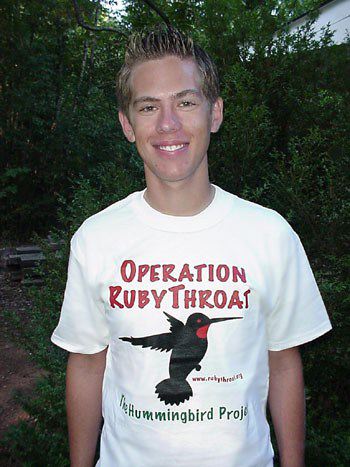
Need a Special Gift for a Want to make a If so, why not use our new handy-dandy on-line Google Checkout below to place your secure credit card order or become a Major Donor today? |
|
|
|
|
SPECIES BANDED THIS WEEK: * = New species for 2008 WEEKLY BANDING TOTAL 28 species 71 individuals YEARLY BANDING TOTAL (2008) 61 species 1,566 individuals 220 Ruby-throated Hummingbirds 27-YEAR BANDING GRAND TOTAL (since 28 June 1982) 124 species 51,733 individuals NOTABLE RECAPTURES THIS WEEK (with original banding date, sex, and current age) 2008 Ruby-throated Hummingbird returns from past years--38 American Goldfinch (1) Eastern Towhee (1) |
OTHER NATURE NOTES OF INTEREST --We continue to be astonished by a fall influx of migrant Ruby-throated Hummingbirds that by September's end had brought our species' season total to 220 banded. That's just six less than our all-time high at Hilton Pond and far, far above where we thought we'd be after exceptionally low banding numbers during spring and early summer. With almost three weeks possibly left in the 2008 RTHU banding season--our latest-ever hummer was on 18 Oct--we might even break the record. --This week's 28 species was the most diverse assemblage of banded birds at the Center in 2008, thanks to a nice post-storm mid-week movement of Wood Warblers. A young male Nashville Warbler on 27 Sep was only our seventh in 26 years of banding, and two Magnolia Warblers caught the same day made that species the 20th member of the highly exclusive "400 Club" at Hilton Pond. |
|
|
|
(Back to Preceding Week; on to Next Week) Up to Top of Page Back to This Week at Hilton Pond Center Current Weather Conditions at Hilton Pond Center |
 You can also post questions for The Piedmont Naturalist |
Join the |
Search Engine for |
|
|
Cheap Musical Instrument

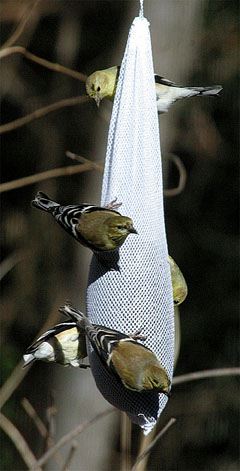 These three "winter finch" species consume prodigious quantities of black sunflower, with some but not all the goldfinches also partaking--meticulously, one seed at a time (right)--from "thistle socks" around our old farmhouse. During winter the goldfinches take on a much drabber appearance, but come spring each male once again acquires brilliant yellow plumage contrasted against jet black wings, tail, and forehead. Females also brighten a bit as they come into breeding condition, although never showing the breathtaking colors of the adult male. Most years the bulk of these brightly plumaged goldfinches depart by early May for expansive breeding grounds across the northern U.S. and southern Canada, with a few individuals (or pairs) lingering into June. We typically have several yellow birds that hang around throughout the summer, but in 2008 we were amazed by how many American Goldfinches we banded from July through September. This influx of summering birds--unprecedented in our 26 years of banding at Hilton Pond Center--presents us with a "Goldfinch Mystery" we're not sure we can explain.
These three "winter finch" species consume prodigious quantities of black sunflower, with some but not all the goldfinches also partaking--meticulously, one seed at a time (right)--from "thistle socks" around our old farmhouse. During winter the goldfinches take on a much drabber appearance, but come spring each male once again acquires brilliant yellow plumage contrasted against jet black wings, tail, and forehead. Females also brighten a bit as they come into breeding condition, although never showing the breathtaking colors of the adult male. Most years the bulk of these brightly plumaged goldfinches depart by early May for expansive breeding grounds across the northern U.S. and southern Canada, with a few individuals (or pairs) lingering into June. We typically have several yellow birds that hang around throughout the summer, but in 2008 we were amazed by how many American Goldfinches we banded from July through September. This influx of summering birds--unprecedented in our 26 years of banding at Hilton Pond Center--presents us with a "Goldfinch Mystery" we're not sure we can explain.
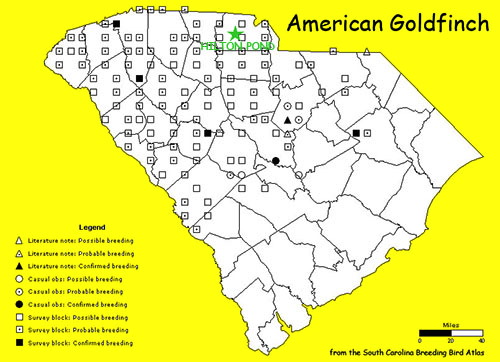

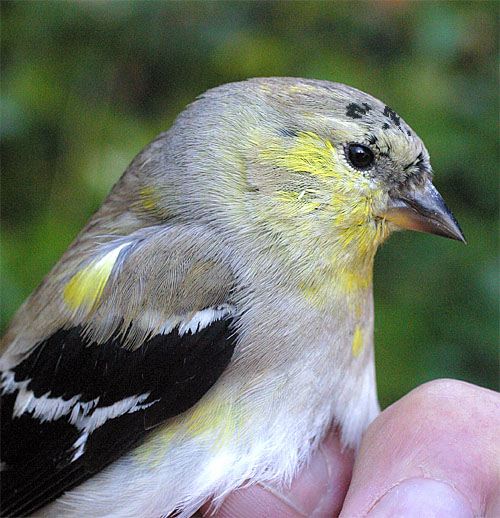

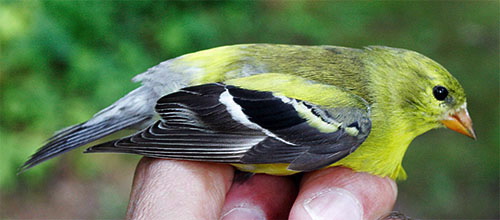
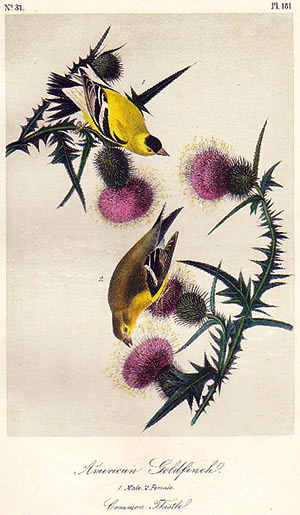 We don't know if goldfinches have mating on their agenda in May and June, but during that time both males and females spend most of the day at the feeders--which means they can't possibly be nesting, incubating, or taking care of hatchlings. They do, however, seem to hang around in couples, so perhaps they are creating or maintaining pair bonds and just waiting for the proper moment.
We don't know if goldfinches have mating on their agenda in May and June, but during that time both males and females spend most of the day at the feeders--which means they can't possibly be nesting, incubating, or taking care of hatchlings. They do, however, seem to hang around in couples, so perhaps they are creating or maintaining pair bonds and just waiting for the proper moment.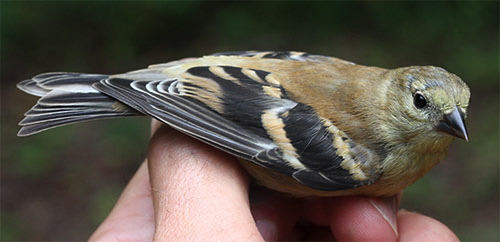
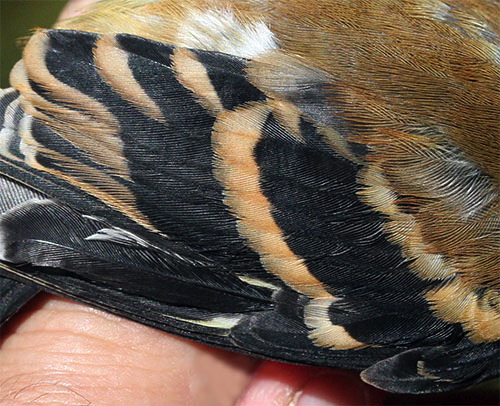
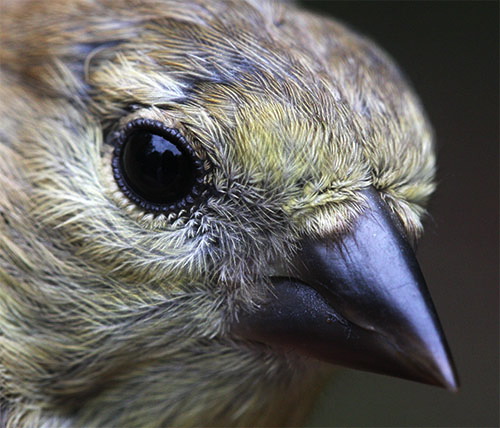
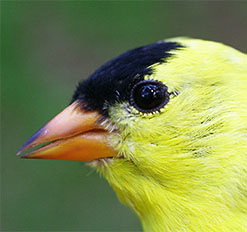


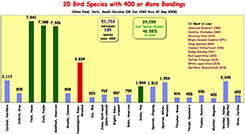
 Please report your
Please report your